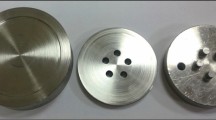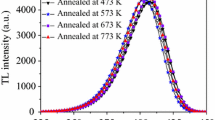Abstract
In the present study, the dosimetric features of pink Himalayan salt pellets were studied. Energy dependence exhibited an over response up to 100 keV with a maximum factor of ~ 10 at 33 keV. The maximum angular dependence of ~ 46% was observed at 90° angle of incidence. The TL response was found to be dose rate independent and showed a good reproducibility with < 5% COV. The sample sensitivity was comparable to TLD-100 (beyond 500 mGy). The effective atomic number (Zeff) was found to be 15.20. Based on these dosimetric features, pink Himalayan salt can be a good potential candidate for therapeutic dosimetry applications.







Similar content being viewed by others
Data availability
The raw/processed data required to reproduce these findings cannot be shared at this time as the data also forms part of an ongoing study.
References
Furetta C (2003) Handbook of thermoluminescence. World Scientific, Singapore
Kortov V (2010) Nanophosphors and outlooks for their use in ionizing radiation detection. Radiat Meas 45:512–515
Alvarez P, Kry S, Stingo F, Followill D (2017) TLD and OSLD dosimetry systems for remote audits of radiotherapy external beam calibration. Radiat Meas 106:412–415
Kron T, Haworth A, Williams I (2013) Dosimetry for audit and clinical trials: challenges and requirements. J Phys Conf Ser 444:012014
Nelson V, McLean I, Holloway L (2008) Use of thermoluminescent dosimetry (TLD) for quality assurance of orthovoltage X-ray therapy machines. Radiat Meas 43:908–911
McKeever SW, Moscovitch M, Townsend PD (1995) Thermoluminescence dosimetry materials: properties and uses
Hayat S, Siddique MT, Wazir-ud-Din M, Jain M (2022) Dosimetric and TL investigation of natural and heat-treated Pakistani Onyx at high beta doses. J Lumin 251:119178
Kalita J, Kaya-Keleş Ş, Çakal G, Meriç N, Polymeris G (2021) Thermoluminescence and optically stimulated luminescence properties of ulexite mineral. J Lumin 230:117759
Mahmood MM, Kakakhel MB, Din MW-U, Hayat S, Ahmad K, Siddique MT et al (2022) Thermoluminescence (TL), kinetic parameters and dosimetric features of pakistani limestone. Appl Radiat Isot 188:110357
Sabry M, Alazab HA, Gad A, El-Faramawy N (2021) Thermoluminescence properties of natural Egyptian calcite. J Lumin 238:118273
Wazir-ud-Din M, Poelman D, De Grave J, Vandenberghe D, Kakakhel MB, Hayat S et al (2023) Thermoluminescence dosimetric and kinetic characterization of Pakistani fluorite after β irradiation. Nucl Instrum Methods Phys Res Sect B 540:246–258
McKeever SW (1988) Thermoluminescence of solids, vol 3. Cambridge University Press, London
Spooner NA, Smith BW, Williams OM, Creighton DF, McCulloch I, Hunter PG et al (2011) Analysis of luminescence from common salt (NaCl) for application to retrospective dosimetry. Radiat Meas 46:1856–1861
Hunter P, Spooner N, Smith B, Creighton D (2012) Investigation of emission spectra, dose response and stability of luminescence from NaCl. Radiat Meas 47:820–824
Polymeris GS, Kitis G, Kiyak NG, Sfamba I, Subedi B, Pagonis V (2011) Dissolution and subsequent re-crystallization as zeroing mechanism, thermal properties and component resolved dose response of salt (NaCl) for retrospective dosimetry. Appl Radiat Isot 69:1255–1262
Bernhardsson C, Christiansson M, Mattsson S, Rääf CL (2009) Household salt as a retrospective dosemeter using optically stimulated luminescence. Radiat Environ Biophys 48:21–28
Callo-Escobar DJ, Cano NF, Rao TG, Gonzales-Lorenzo CD, Turpo-Huahuasoncco KV, Pacompia Y et al (2022) Identification of ESR centers and their role in the TL of natural salt from Lluta, Peru. Appl Radiat Isot 182:110126
Gonzales-Lorenzo CD, Callo-Escobar DJ, Ccollque-Quispe AA, Rao TG, Aragón F, Aquino J et al (2022) Effect of annealing temperature on the structural, thermoluminescent, and optical properties of naturally present salt from Lluta region of Peru. Opt Mater 126:112215
Anjum MI, Ur Rehman S, Kakakhel MB, Siddique MT, Mahmood MM, Hayat S et al (2022) Thermoluminescence study of Pink Himalayan salt from Khewra mines, Pakistan. J Lumin 252:119329
Ahmad K, Kakakhel MB, Hayat S, Wazir-ud-Din M, Mahmood MM, Rehman SU et al (2021) Thermoluminescence study of pellets prepared using NaCl from Khewra Salt Mines in Pakistan. Radiat Environ Biophys 60:365–375
Elashmawy M (2018) Study of constraints in using household NaCl salt for retrospective dosimetry. Nucl Instrum Methods Phys Res Sect B 423:49–61
Yüce ÜR, Engin B (2017) Effect of particle size on the thermoluminescence dosimetric properties of household salt. Radiat Meas 102:1–9
Horowitz Y, Oster L, Eliyahu I (2018) Review of dose-rate effects in the thermoluminescence of LiF: Mg, Ti (Harshaw). Radiat Prot Dosimetry 179:184–188
Khazal KAR, Abul-Hail RC (2010) Study of the possibility of using food salt as a gamma ray dosimeter. Nucl Instrum Methods Phys Res Sect A 624:708–715
Waldner L, Rääf C, Hinrichsen Y, Herrnsdorf L, Bernhardsson C (2020) Experimentally determined and Monte Carlo–calculated energy dependence of NaCl pellets read by optically stimulated luminescence for photon beams in the energy range 30 keV to 1.25 MeV. J Radiol Prot 40:1321
Azim MM, Sani SA, Daar E, Khandaker M, Almugren K, Alkallas F et al (2020) Luminescence properties of natural dead sea salt pellet dosimetry upon thermal stimulation. Radiat Phys Chem 176:108964
Guimarães C, Moralles M, Okuno E (2007) GEANT4 simulation of the angular dependence of TLD-based monitor response. Nucl Instrum Methods Phys Res Sect A 580:514–517
Jin H, Duftschmid KE, Strachotinsky C (1992) Investigation of a new LiF TLD individual dosimeter for measuring personal dose equivalent Hp (d) on different phantoms. Oesterreichisches Forschungszentrum Seibersdorf GmbH, Seibersdorf
Vohra K, Bhatt R, Chandra B, Pradhan A, Lakshmanan A, Shastry S (1980) A personnel dosimeter TLD badge based on CaSO4: Dy Teflon TLD discs. Health Phys 38:193–197
Ahmad K, Kakakhel MB, Hayat S, Wazir-Ud-Din M, Mahmood MM, Ur-Rehman S et al (2022) Dosimetric properties of thermoluminescent NaCl pellets from Khewra Salt Mines Pakistan. Luminescence 37:1701–9
Fayet-Moore F, Wibisono C, Carr P, Duve E, Petocz P, Lancaster G et al (2020) An analysis of the mineral composition of pink salt available in Australia. Foods 9:1490
Nambi K (1977) Thermoluminescence: Its understanding and applications. Instituto de Energia Atomica, Rio de Janeiro
Lopez F, Cabrera J, Agullo-Lopez F (1979) Radiation-induced colouring in NaCl: Mn2+. J Phys C Solid State Phys 12:1221
Hernandez J, Camarillo E, Munoz G, Flores C, Cabrera E, Jaque F et al (2001) Red and green fluorescence of Mn2+ in NaCl. Opt Mater 17:491–495
Davidson AT, Kozakiewicz AG, Derry TE, Comins JD, Suszynska M (2004) Effects of various dopants on NaCl and KCl glow curves. Nucl Instrum Methods Phys Res Sect B 218:249–254
Datz H, Druzhyna S, Oster L, Orion I, Horowitz Y (2016) Study of the suitability of Israeli household salt for retrospective dosimetry. Radiat Prot Dosim 170:407–411
Kry SF, Alvarez P, Cygler JE, DeWerd LA, Howell RM, Meeks S et al (2020) AAPM TG 191: clinical use of luminescent dosimeters: TLDs and OSLDs. Med Phys 47:e19–e51
Oliveira EL, De Barros VS, Asfora VK, Khoury HJ (2018) Evaluation of a LiF: Mg, Ti thermoluminescent ring dosimeter according to the IEC 62387: 2012 Standards. J Phys Conf Ser 975:012036
Luo L, Benevides L, Streetz K, McKee C (2017) Type testing a new personnel dosimetry system to IEC 62387. Radiat Meas 106:525–530
Wazir-ud-Din M, Mahmood MM, Ahmad K, Hayat S, Siddique MT, Kakakhel MB et al (2022) Computerized glow curve deconvolution (CGCD): a comparison using asymptotic vs rational approximation in thermoluminescence kinetic models. Appl Radiat Isot 179:110014
Bos AJ (2006) Theory of thermoluminescence. Radiat Meas 41:S45–S56
Balian HG, Eddy NW (1977) Figure-of-merit (FOM), an improved criterion over the normalized chi-squared test for assessing goodness-of-fit of gamma-ray spectral peaks. Nucl Inst Methods 145:389–395
Kurudirek M (2014) Effective atomic numbers and electron densities of some human tissues and dosimetric materials for mean energies of various radiation sources relevant to radiotherapy and medical applications. Radiat Phys Chem 102:139–146
Khan FM, Gibbons JP (2014) Khan’s the physics of radiation therapy. Lippincott Williams & Wilkins, Philadelphia
Furetta C (2010) Handbook of thermoluminescence. World Scientific, Singapore
Souza LF, Santos WS, Belinato W, Silva RMV, Caldas LVE, Souza DN (2019) Mass energy absorption coefficients and energy responses of magnesium tetraborate dosimeters for 0.02 MeV to 2.0 MeV photons using Monte Carlo simulations. Appl Radiat Isot 148:232–239
Malthez AL, Freitas MB, Yoshimura EM, Button VL (2014) Experimental photon energy response of different dosimetric materials for a dual detector system combining thermoluminescence and optically stimulated luminescence. Radiat Meas 71:133–138
Ekendahl D, Bulánek B, Judas L (2016) A low-cost personal dosemeter based on optically stimulated luminescence (OSL) of common household salt (NaCl). Radiat Meas 85:93–98
Tochilin E, Goldstein N (1966) Dose rate and spectral measurements from pulsed x-ray generators. Health Phys 12:1705–1714
Moor D, Horspool B, Stokes R (2008) Performance of the Harshaw DXT-RAD (TLD-100) dosemeter. Radiat Meas 43:533–537
Halefoglu Y, Oglakci M, Portakal Z, Akca S, Souadi G, Canimoglu A et al (2020) A study on thermoluminescence behaviour of Eu doped LaB3O6 irradiated with beta particles. Radiat Phys Chem 168:108571
N. B. Wahib, S. Abdul Sani, A. Ramli, S. Ismail, M. H. Abdul Jabar, M. U. Khandaker, et al., "Natural dead sea salt and retrospective dosimetry," Radiation and environmental biophysics, vol. 59, pp. 523–537, 2020.
Mehrabi M, Zahedifar M, Saeidi-Sogh Z, Ramazani-Moghaddam-Arani A, Sadeghi E, Harooni S (2017) Thermoluminescence and photoluminescence properties of NaCl: Mn, NaCL: Cu nano-particles produced using co-precipitation and sono-chemistry methods. Nucl Instrum Methods Phys Res Sect A 846:87–93
Acknowledgements
Authors are grateful to Secondary Standard Dosimetry Laboratory (SSDL), Radiation Dosimetry Group (RDG) and Central Analytical Facility Division (CAFD), PINSTECH, Islamabad for providing the irradiation, TL measurement and ICP-OES facilities respectively.
Funding
This research did not receive any specific grant from funding agencies in the public, commercial, or not-for-profit sectors.
Author information
Authors and Affiliations
Contributions
MIA: Conceptualization, Data curation, Investigation, Writing – original draft, SR: Conceptualization, Reviewing and Editing, MBK: Resources, Reviewing, Editing, MTS: Resources, Visualization B: Resources, SN: Resources, Investigation.
Corresponding author
Ethics declarations
Competing interest
The authors declare that they have no known competing financial interests or personal relationships that could have appeared to influence the work reported in this paper.
Additional information
Publisher's Note
Springer Nature remains neutral with regard to jurisdictional claims in published maps and institutional affiliations.
Rights and permissions
Springer Nature or its licensor (e.g. a society or other partner) holds exclusive rights to this article under a publishing agreement with the author(s) or other rightsholder(s); author self-archiving of the accepted manuscript version of this article is solely governed by the terms of such publishing agreement and applicable law.
About this article
Cite this article
Anjum, M.I., Ur Rehman, S., Kakakhel, M.B. et al. Thermoluminescence (TL) dosimetric characteristics of pink Himalayan salt from Khewra, Pakistan. J Radioanal Nucl Chem 333, 917–925 (2024). https://doi.org/10.1007/s10967-023-09329-x
Received:
Accepted:
Published:
Issue Date:
DOI: https://doi.org/10.1007/s10967-023-09329-x




